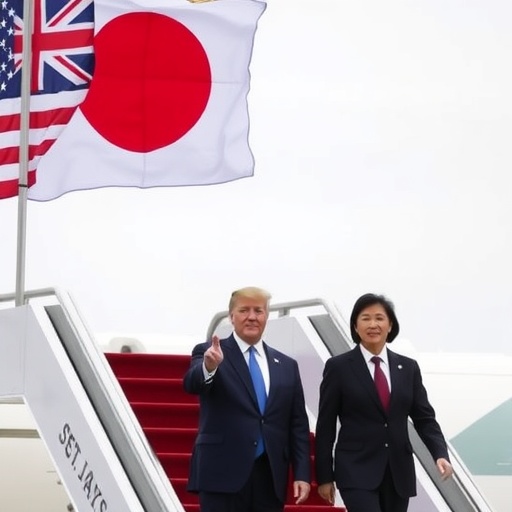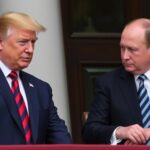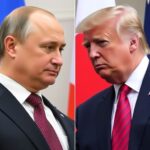President Trump Launches Three-Day State Visit to Japan for Landmark Talks with Prime Minister Sanae Takaichi on Bolstering U.S.-Japan Alliance
In a pivotal moment for trans-Pacific diplomacy, U.S. President Donald Trump is set to touch down in Tokyo on Monday, kicking off a three-day state visit to Japan that promises to reshape the U.S.-Japan alliance amid escalating regional tensions. This trip marks Trump‘s first face-to-face encounter with Japan’s newly appointed Prime Minister Sanae Takaichi, a conservative leader whose rise has sparked intrigue in Washington and beyond. As North Korea’s missile tests loom large and China’s assertiveness in the South China Sea intensifies, the leaders’ discussions could forge a stronger bulwark against shared threats, analysts say.
- Trump’s Grand Arrival in Tokyo: Ceremonies and Diplomatic Fanfare
- Sanae Takaichi’s Rise: A New Era for Japan’s Leadership and U.S. Ties
- Fortifying the U.S.-Japan Alliance: Defense Upgrades and Joint Drills
- Economic Pillars and Trade Negotiations: Beyond Security to Prosperity
- Regional Ripples and Future Horizons: What Comes After the Visit
The visit comes at a time when the Indo-Pacific region is a powder keg of geopolitical friction. With Trump fresh off domestic political battles, his journey to the Land of the Rising Sun underscores America’s unwavering commitment to its oldest ally in Asia. White House officials have teased “robust” agenda items, from military interoperability to economic pacts, signaling that this isn’t just ceremonial pomp but a strategic pivot. Japanese media outlets are abuzz, with polls showing 68% of citizens viewing the alliance as vital to national security, per a recent Asahi Shimbun survey.
Historical context adds weight to the occasion. The U.S.-Japan alliance, forged in the ashes of World War II and cemented by the 1960 Treaty of Mutual Cooperation and Security, has evolved into a cornerstone of global stability. Under Trump‘s first term, the partnership saw unprecedented defense spending hikes from Tokyo—Japan pledged $2.5 billion annually for U.S. bases by 2020. Now, with Sanae Takaichi at the helm, there’s renewed vigor to counterbalance Beijing’s expansionism.
Trump’s Grand Arrival in Tokyo: Ceremonies and Diplomatic Fanfare
As Air Force One glides into Haneda Airport, President Trump will be greeted by a spectacle of tradition and modernity that defines Japan‘s diplomatic flair. Prime Minister Sanae Takaichi, flanked by Emperor Naruhito and Empress Masako, will host a state banquet at the Imperial Palace, where cherry blossoms—though slightly past peak season—will frame the evening’s toasts. This state visit protocol, rarely extended to sitting U.S. presidents, highlights the depth of bilateral ties; only three such honors have been bestowed since 2000.
Security will be airtight, with over 5,000 Japanese police and U.S. Secret Service agents coordinating to shield the entourage from potential protests. Environmental activists, concerned about U.S. military expansions on Okinawa, have planned small demonstrations, but officials downplay disruptions. “This visit is about unity, not division,” a Japanese Foreign Ministry spokesperson told reporters, emphasizing the symbolic weight of Trump laying a wreath at the Yasukuni Shrine—a site fraught with historical sensitivities for China and Korea.
Behind the pageantry, logistics reveal the visit’s scale. Trump‘s motorcade will traverse Tokyo’s neon-lit streets to the U.S. ambassador’s residence, where he’ll hold private meetings with business leaders from Toyota and Sony. These interactions aren’t mere photo ops; they pave the way for trade talks, building on the 2019 U.S.-Japan Trade Agreement that slashed tariffs on $7.2 billion in American exports like beef and ethanol.
Sanae Takaichi’s Rise: A New Era for Japan’s Leadership and U.S. Ties
Sanae Takaichi, Japan’s first female prime minister in nearly a decade, brings a hawkish worldview shaped by her tenure as defense minister from 2021 to 2023. At 62, the Kyoto native has championed constitutional revisions to expand Japan’s Self-Defense Forces, a stance that aligns seamlessly with Trump‘s “America First” security demands. Her election in September 2024, following Fumio Kishida’s resignation amid scandal, was a surprise upset, propelled by her nationalist rhetoric and promises to fortify the U.S.-Japan alliance.
Analysts praise Takaichi‘s pragmatic approach. “She’s not just a figurehead; her experience in LDP factions makes her a formidable partner for Trump,” said Dr. Emily Chen, a Japan expert at the Brookings Institution. In a pre-visit interview with NHK, Takaichi stated, “The alliance with the United States is the bedrock of our peace. Together, we must deter aggression from any quarter.” This echoes Trump‘s past praise for Japan’s defense contributions, including the 2022 Quad summit where he lauded Tokyo’s $10 billion arms package.
Gender dynamics add a layer of intrigue. As a trailblazer, Takaichi faces scrutiny over work-life balance in politics, but her visit with Trump could spotlight women’s roles in global leadership. Japanese women hold just 10% of Diet seats, per World Bank data, making her ascent a beacon for reform. The duo’s chemistry will be watched closely; Trump, known for his deal-making bravado, reportedly admires her no-nonsense style, sources close to the White House confide.
Fortifying the U.S.-Japan Alliance: Defense Upgrades and Joint Drills
At the heart of the state visit lies a laser-focused agenda on beefing up the U.S.-Japan alliance. Topping the list: enhanced missile defense cooperation against North Korea’s provocations. Pyongyang’s 2024 launches—over 30 ballistic missiles, including one that splashed down near U.S. bases in Guam—have heightened alarms. Trump and Sanae Takaichi are expected to announce a joint command structure for rapid response, potentially integrating Japan’s Aegis destroyers with U.S. THAAD systems.
Military stats underscore the urgency. The U.S. maintains 54,000 troops in Japan, the largest overseas contingent, costing Tokyo $2 billion yearly in host-nation support. Recent joint exercises, like the biennial Keen Sword drills involving 47,000 personnel, simulated island invasions mirroring Taiwan scenarios. “We’re not just allies; we’re family in the face of tyranny,” Trump tweeted last week, hinting at deeper integration.
China’s shadow looms large. Beijing’s military budget, now $296 billion annually (SIPRI 2024), dwarfs Japan’s $50 billion, prompting calls for Tokyo to hit 2% GDP defense spending by 2027—a goal Takaichi endorses. Discussions may yield a new intelligence-sharing pact, building on the 2015 U.S.-Japan Acquisition and Cross-Servicing Agreement. Experts like retired Admiral James Stavridis warn, “Without a fortified alliance, the Indo-Pacific balance tips toward authoritarianism.” Quotes from Pentagon officials suggest Trump will push for Japanese involvement in AUKUS Pillar II tech sharing, encompassing hypersonics and cyber defenses.
Beyond hardware, cultural exchanges bolster ties. The visit includes a nod to U.S. Marines and Japanese forces training together in Hokkaido, where harsh winters forge unbreakable bonds. Veterans from both nations will share stories at a gala dinner, humanizing the alliance’s stakes.
Economic Pillars and Trade Negotiations: Beyond Security to Prosperity
While security dominates headlines, economic dialogues during Trump‘s state visit to Japan could unlock billions in mutual gains. The U.S. trade deficit with Japan stands at $68 billion (2023 Census Bureau), fueled by autos and electronics. Sanae Takaichi, a free-trade advocate despite her conservative bent, seeks to expand the digital trade chapter of the existing pact, targeting AI and semiconductors—critical amid U.S. chip wars with China.
Key sessions at the prime minister’s office will address supply chain resilience. Post-COVID disruptions exposed vulnerabilities; Japan supplies 30% of U.S. auto parts, per Commerce Department figures. Trump aims to repatriate some manufacturing, but with incentives like joint R&D hubs in semiconductors. Toyota’s $13.9 billion U.S. investment since 2017 exemplifies success stories, and Takaichi may pledge more to appease Trump‘s tariff threats.
Climate and energy round out talks. As Japan phases out coal by 2035, U.S. LNG exports—valued at $4.5 billion in 2023—offer a bridge. A potential memorandum could accelerate green tech collaborations, aligning with Biden-era initiatives Trump has vowed to refine. Business roundtables with CEOs like Akio Toyoda will inject dynamism, with whispers of a “Phase Two” trade deal encompassing agriculture and services.
Public sentiment favors deeper ties: A 2024 Pew survey found 78% of Japanese view the U.S. positively, up from 68% in 2020. Yet, challenges persist—farmers in Hokkaido protest U.S. imports, demanding safeguards. Takaichi‘s balancing act will test her negotiation prowess opposite Trump‘s unpredictable style.
Regional Ripples and Future Horizons: What Comes After the Visit
As President Trump‘s three-day state visit to Japan unfolds, its echoes will reverberate across Asia and beyond. A joint statement expected on Wednesday could formalize commitments, from increased patrols in the East China Sea to cyber threat pacts, signaling a united front against coercion. If successful, this meeting with Sanae Takaichi might catalyze broader Quad enhancements, drawing in Australia and India for multinational exercises by 2025.
Looking ahead, the U.S.-Japan alliance could pivot toward offensive capabilities, with Japan eyeing long-range strike missiles—a taboo until recently. Economically, a fortified partnership might stabilize global markets, countering inflation from supply shocks. For Trump, it’s a diplomatic win amid 2024 election pressures, bolstering his image as a global strongman.
Challenges remain: Domestic politics in both nations could stall progress. Takaichi faces LDP infighting, while Trump navigates congressional hawks. Yet, optimists see this as a turning point. “The alliance isn’t static; it’s evolving to meet 21st-century threats,” noted Foreign Policy analyst Bonnie Glaser. As the leaders bid farewell at Narita Airport, the world watches for signs of a more secure, prosperous Indo-Pacific—one handshake at a time.
In the days following, follow-up summits at the G7 in 2025 could build momentum, potentially inviting ASEAN partners to dilute China’s influence. For now, this visit reaffirms an enduring bond: allies standing tall against the storms of uncertainty.









